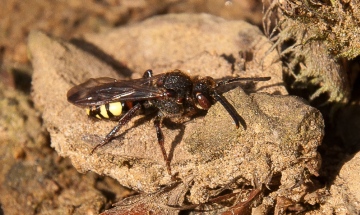Species Account for Nomada leucophthalma
Nomada leucophthalma (Kirby, 1802)
a cuckoo bee
Aculeata: Anthophorinae

Reproduction for study and non-profit use permitted, all other rights reserved.
Taxonomic group: bees and wasps (Aculeata) - County data
View time series maps for Nomada leucophthalma
member log-on for taxon report
Essex RDB: Listed
Threat: Essex Endangered
Images
upload a new image
Essex Red Data List comment
Cleptoparasite on Andrena clarkella. Recorded from the Colchester district by Harwood (1884) rare, about burrows of Andrena clarkella and noted again by Nicholson (1928). Until 2012, when Dr Jeremy Dagley found the species with a colony of its host in Epping Forest, there were no recent records. However the host is still fairly numerous in several localities and probably under-recorded. (Harvey & Plant, 1996).
Habitats
Why not join the Club, register and add a new species page
Interpretation of distribution maps



















